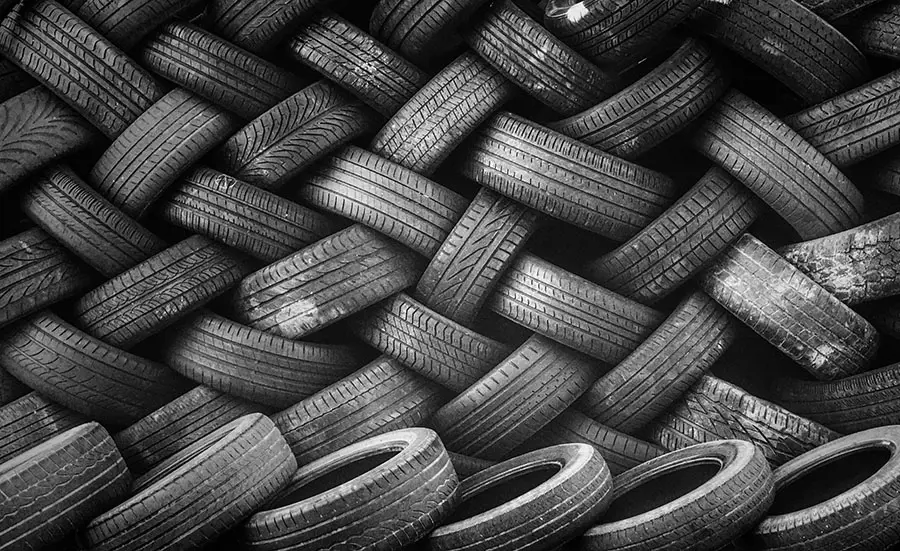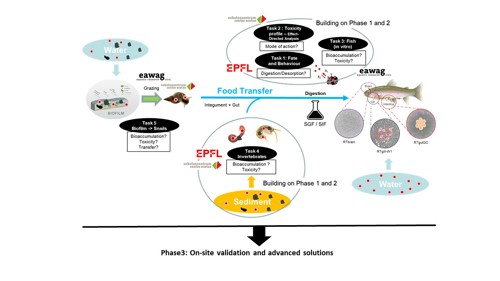
Ecotoxicity of tire wear particles
Every year, several thousand tons of tire wear particles end up in the environment, consisting of a complex mixture of rubber particles and road material and contaminated with numerous pollutants. Tire wear particles consist of rubber, vulcanizing agents and other additives. Due to friction on the road, the particles also contain asphalt and impurities originating from the road surface. Tire wear particles has now been detected in all environmental compartments: Air, water, sediment, soil and biota. The ecotoxicity of the particles depends directly on the bioavailability of the particle-bound chemicals, which is influenced by the ageing of the particles.
The aim of the project is to better understand the bioavailability and toxicity of contaminants in tire wear particles and the direct effects of the particles on organisms. For this purpose, the pathway of the contaminants between particle absorption in the intestine, desorption during digestion, absorption via the digestive tract and bioaccumulation in the tissue is considered. In addition to the desorption of substances during digestion, the presence of pollutants with specific mechanisms of action and the effects at the molecular, cellular and organism level are investigated. Cryogenically milled tire tread are used as model material for tire wear particles.
The project is funded by the World Business Council for Sustainable Development (WBCSD) as part of the Tire Industry Project (TIP).

Phase 1 2019 - 2021
- Desorption of pollutants from unaltered and aged tire particles in artificial gastric and intestinal fluid and under environmental conditions
- Estrogenic and genotoxic effects of contaminants after digestion of tire particles with artificial gastric and intestinal fluid or leaching with water. The effect of the extracts is detected using a combination of thin-layer chromatography, bioassays and mass spectroscopy.
- Toxicity of particles and of extracts after digestion/leaching on fish cell lines (from gills and intestine of rainbow trout)
- Bioaccumulation and effects of particles and associated contaminants on terrestrial and aquatic invertebrates
Phase 2 2022 - 2023
In addition to the objectives from phase 1, the effect of tire wear particles on aquatic biofilms and the possible transfer of tire wear particles and their chemical components along an artificial food chain will be investigated.The toxicity on brain fish cell lines will be also investigated.
- Desorption of chemicals from organisms contaminated with tire wear particles (which serve as food source for rainbow trout).
- Toxicity profile of tire particle extracts after digestion/leaching. Estrogenicity, genotoxicity and general toxicity to bacteria are considered. The effects are detected using a combination of thin layer chromatography, bioassays and mass spectroscopy.
- Toxicity of particles and extracts after digestion/leaching on fish cell lines (from gills, gut and brain).
- Bioaccumulation and effects of particles and particle-bound contaminants on chironomids and gammarids
- Bioaccumulation and effects of particles and bound contaminants on biofilms, assessment of transfer via the food chain to snails grazing on them
Phase 3 2024 - 2025
The investigations from phase 2 will be continued. The aim is also to determine which chemicals are responsible for the observed effects. The laboratory tests will be compared with the analysis of environmental samples. In addition, a package of methods for the evaluation of tire constituents will be proposed and possible alternatives with lower toxicity will be tested.
- On the way to in-situ (bio)monitoring along the food chain. Analysis of environmental samples (water, sediment and organisms) for tire particles and associated contaminants. Assessment of effects by measuring biomarkers. Are tire additives transferred to higher levels in the food chain?
- Identification of chemicals of concern using a combination of thin layer chromatography, bioassays and mass spectroscopy to support risk assessment. DR-Calux on thin-layer plates will also be established to detect dioxin-like effects.
- Development of a method package based on fish cell lines from gills, intestine and brain to determine the toxicity of various tire constituents with different mechanisms of action and - where necessary - to look for alternatives.
- Freshwater gammarids and chironomids from environmental samples - food for the trout - are digested and tested for toxicity using fish cell lines. Determination of residues of prioritized substances in tissue and analysis of biomarkers.
- Investigation of the bioaccumulation of tire particles in biofilms and their transfer to grazing snails under environmental conditions. Determination of the effect profile of the tire ingredients by feeding them to suitable organisms.
Publications
Dudefoi, W., Ferrari, B. J. D., Breider, F., Masset, T., Leger, G., Vermeirssen, E., … Schirmer, K. (2024). Evaluation of tire tread particle toxicity to fish using rainbow trout cell lines. Science of the Total Environment, 912, 168933. doi.org/10.1016/j.scitotenv.2023.168933 , Institutional Repository
Masset, T., Ferrari, B. J. D., Dudefoi, W., Schirmer, K., Bergmann, A., Vermeirssen, E., … Breider, F. (2022). Bioaccessibility of organic compounds associated with tire particles using a fish in vitro digestive model: solubilization kinetics and effects of food coingestion. Environmental Science and Technology, 56(22), 15607-15616. doi.org/10.1021/acs.est.2c04291 , Institutional Repository
Masset, T., Ferrari, B. J. D., Oldham, D., Dudefoi, W., Minghetti, M., Schirmer, K., … Breider, F. (2021). In vitro digestion of tire particles in a fish model (Oncorhynchus mykiss): solubilization kinetics of heavy metals and effects of food coingestion. Environmental Science and Technology, 55(23), 15788-15796. doi.org/10.1021/acs.est.1c04385 , Institutional Repository
